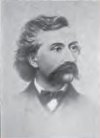Five Unknown Soldiers and The Spring
Tour Stop
Directions: The spring that was used by the Federal defenders for a water supply is located on the grounds of the Battle of Lexington State Historic Site at 1101 Delaware Street, Lexington Missouri 64067.
The spring itself is not easily accessible, but you can get an idea of where it was by walking over to the memorial grave site for the "Five Unknown Soldiers" [ Waypoint = N39 11.470 W93 52.659 ]. This is located off to the right (east) just inside the entrance to the battlefield. Walk over to the edge of the wooded ravine. The spring is located down in the hollow just to the east of the grave marker.
 |
 |
Description: The bodies of the five soldiers buried here were discovered in 1932 during work being done near the old Masonic College building. Although their identities are unknown, they are thought to have been members of Colonel Thomas A. Marshall's 1st Illinois Cavalry.
In preparation for his defense of the Federal garrison, Colonel Mulligan had ordered the two cisterns inside of the entrenchments to be filled with water. The Federals had access to two sources of water, the spring, located just to the east of where you are standing, and the Missouri River located down the bluffs to the west. Both of these water sources were outside of the entrenchments. As the weather turned hot and dry, the Federals' water consumption increased dramatically.
 The Federals had made a mistake in their preparations. Colonel Marshall's 700 cavalrymen were poorly armed and would not contribute much to the fighting. Their horses would end up drinking most of the scarce water supplies, which was described after the war by Major R. T. Van Horn:
The Federals had made a mistake in their preparations. Colonel Marshall's 700 cavalrymen were poorly armed and would not contribute much to the fighting. Their horses would end up drinking most of the scarce water supplies, which was described after the war by Major R. T. Van Horn:
"The first mistake (and a fatal one) was that Col. Marshall's cavalry, which had not received its carbines, being armed only with sabres and some old holster pistols, was not sent over the river by the boats yet under our control. It was those horses, the finest I ever saw together--owned by the men who rode them--that exhausted our water supply and weakened our lines of defense, necessarily extended to protect them."
Cutting the Federal defenders off from their water sources was part of Price's plan to force their surrender with a minimum of Missouri State Guard casualties. He wrote the following in his official report of the battle:
"Skirmishers and sharp-shooters were also sent forward from both of these divisions [Rains' 8th and Parson's 6th] to harass and fatigue the enemy, and to cut them off from the water on the north, east, and south of the college, and did inestimable service in the accomplishment of these purposes."
By 11:00 A.M. on September 18th, Brigadier General James S. Rains had placed his Eighth Division "in an entirely protected position, about 350 yards north and about 500 yards east" of the Federal entrenchments. He set out skirmishers to prevent the Federals from getting access to the spring and therefore water. Rains reported that "one sally was made by the enemy on the evening of the 18th, which was quickly repulsed."
 Later during the war, Colonel James A. Mulligan gave a lecture on the Battle of Lexington which was reported in a newspaper (Colonel Mulligan's official report of the battle never reached Washington). He described the effects of the lack of water on his troops:
Later during the war, Colonel James A. Mulligan gave a lecture on the Battle of Lexington which was reported in a newspaper (Colonel Mulligan's official report of the battle never reached Washington). He described the effects of the lack of water on his troops:
"On the morning of the 19th the firing was resumed and continued all day. The officers had told our men that if we could hold out to the 19th we would be re-inforced, and all through the day the men watched anxiously for the appearance of a friendly flag under which aid was to reach them, and listened eagerly for the sound of friendly cannon. But they looked and listened in vain, and all day long they fought without water, their parched lips cracking, their tongues swollen, and the blood running down their chins when they bit their cartridges, and the saltpeter entered their cracked and blistered lips, but not a word of murmuring."
Back: Lexington Battlefield
Next: Federal Entrenchments
